Yosuke Kashiwagi
ESPnet-SDS: Unified Toolkit and Demo for Spoken Dialogue Systems
Mar 11, 2025Abstract:Advancements in audio foundation models (FMs) have fueled interest in end-to-end (E2E) spoken dialogue systems, but different web interfaces for each system makes it challenging to compare and contrast them effectively. Motivated by this, we introduce an open-source, user-friendly toolkit designed to build unified web interfaces for various cascaded and E2E spoken dialogue systems. Our demo further provides users with the option to get on-the-fly automated evaluation metrics such as (1) latency, (2) ability to understand user input, (3) coherence, diversity, and relevance of system response, and (4) intelligibility and audio quality of system output. Using the evaluation metrics, we compare various cascaded and E2E spoken dialogue systems with a human-human conversation dataset as a proxy. Our analysis demonstrates that the toolkit allows researchers to effortlessly compare and contrast different technologies, providing valuable insights such as current E2E systems having poorer audio quality and less diverse responses. An example demo produced using our toolkit is publicly available here: https://huggingface.co/spaces/Siddhant/Voice_Assistant_Demo.
Task Arithmetic for Language Expansion in Speech Translation
Sep 17, 2024
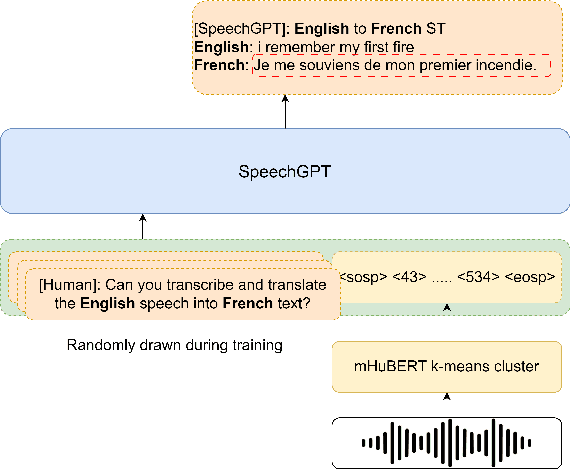

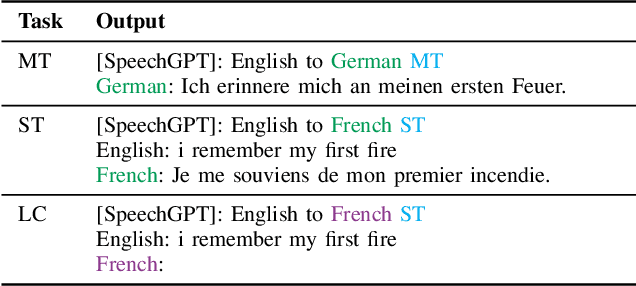
Abstract:Recent advances in large language models (LLMs) have gained interest in speech-text multimodal foundation models, achieving strong performance on instruction-based speech translation (ST). However, expanding language pairs from an existing instruction-tuned ST system is costly due to the necessity of re-training on a combination of new and previous datasets. We propose to expand new language pairs by merging the model trained on new language pairs and the existing model, using task arithmetic. We find that the direct application of task arithmetic for ST causes the merged model to fail to follow instructions; thus, generating translation in incorrect languages. To eliminate language confusion, we propose an augmented task arithmetic method that merges an additional language control model. It is trained to generate the correct target language token following the instructions. Our experiments demonstrate that our proposed language control model can achieve language expansion by eliminating language confusion. In our MuST-C and CoVoST-2 experiments, it shows up to 4.66 and 4.92 BLEU scores improvement, respectively. In addition, we demonstrate the use of our task arithmetic framework can expand to a language pair where neither paired ST training data nor a pre-trained ST model is available. We first synthesize the ST system from machine translation (MT) systems via task analogy, then merge the synthesized ST system to the existing ST model.
Decoder-only Architecture for Streaming End-to-end Speech Recognition
Jun 23, 2024


Abstract:Decoder-only language models (LMs) have been successfully adopted for speech-processing tasks including automatic speech recognition (ASR). The LMs have ample expressiveness and perform efficiently. This efficiency is a suitable characteristic for streaming applications of ASR. In this work, we propose to use a decoder-only architecture for blockwise streaming ASR. In our approach, speech features are compressed using CTC output and context embedding using blockwise speech subnetwork, and are sequentially provided as prompts to the decoder. The decoder estimates the output tokens promptly at each block. To this end, we also propose a novel training scheme using random-length prefix prompts to make the model robust to the truncated prompts caused by blockwise processing. An experimental comparison shows that our proposed decoder-only streaming ASR achieves 8% relative word error rate reduction in the LibriSpeech test-other set while being twice as fast as the baseline model.
Finding Task-specific Subnetworks in Multi-task Spoken Language Understanding Model
Jun 18, 2024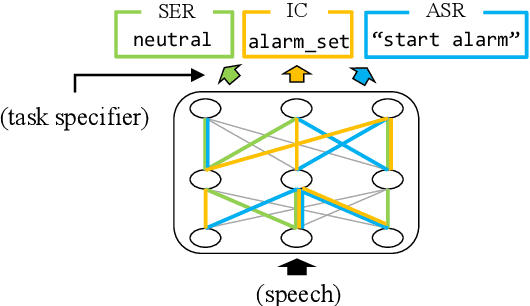
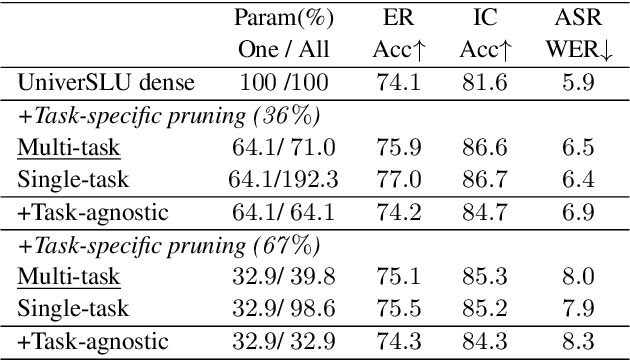
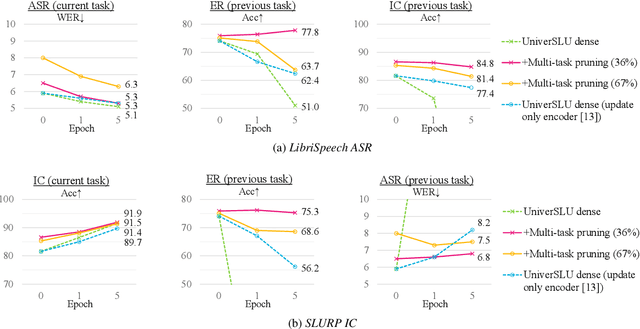

Abstract:Recently, multi-task spoken language understanding (SLU) models have emerged, designed to address various speech processing tasks. However, these models often rely on a large number of parameters. Also, they often encounter difficulties in adapting to new data for a specific task without experiencing catastrophic forgetting of previously trained tasks. In this study, we propose finding task-specific subnetworks within a multi-task SLU model via neural network pruning. In addition to model compression, we expect that the forgetting of previously trained tasks can be mitigated by updating only a task-specific subnetwork. We conduct experiments on top of the state-of-the-art multi-task SLU model ``UniverSLU'', trained for several tasks such as emotion recognition (ER), intent classification (IC), and automatic speech recognition (ASR). We show that pruned models were successful in adapting to additional ASR or IC data with minimal performance degradation on previously trained tasks.
Rapid Language Adaptation for Multilingual E2E Speech Recognition Using Encoder Prompting
Jun 18, 2024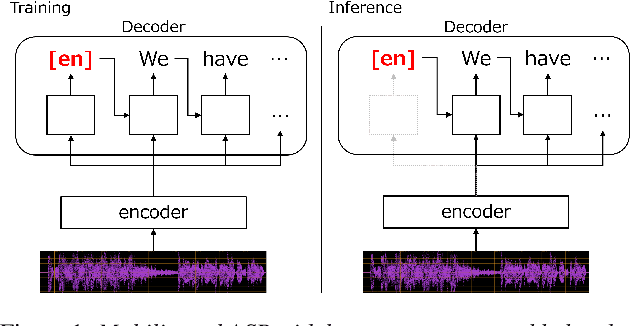

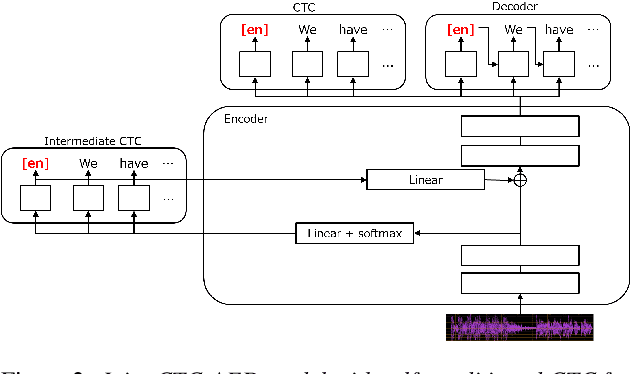

Abstract:End-to-end multilingual speech recognition models handle multiple languages through a single model, often incorporating language identification to automatically detect the language of incoming speech. Since the common scenario is where the language is already known, these models can perform as language-specific by using language information as prompts, which is particularly beneficial for attention-based encoder-decoder architectures. However, the Connectionist Temporal Classification (CTC) approach, which enhances recognition via joint decoding and multi-task training, does not normally incorporate language prompts due to its conditionally independent output tokens. To overcome this, we introduce an encoder prompting technique within the self-conditioned CTC framework, enabling language-specific adaptation of the CTC model in a zero-shot manner. Our method has shown to significantly reduce errors by 28% on average and by 41% on low-resource languages.
Phoneme-aware Encoding for Prefix-tree-based Contextual ASR
Dec 15, 2023Abstract:In speech recognition applications, it is important to recognize context-specific rare words, such as proper nouns. Tree-constrained Pointer Generator (TCPGen) has shown promise for this purpose, which efficiently biases such words with a prefix tree. While the original TCPGen relies on grapheme-based encoding, we propose extending it with phoneme-aware encoding to better recognize words of unusual pronunciations. As TCPGen handles biasing words as subword units, we propose obtaining subword-level phoneme-aware encoding by using alignment between phonemes and subwords. Furthermore, we propose injecting phoneme-level predictions from CTC into queries of TCPGen so that the model better interprets the phoneme-aware encodings. We conducted ASR experiments with TCPGen for RNN transducer. We observed that proposed phoneme-aware encoding outperformed ordinary grapheme-based encoding on both the English LibriSpeech and Japanese CSJ datasets, demonstrating the robustness of our approach across linguistically diverse languages.
UniverSLU: Universal Spoken Language Understanding for Diverse Classification and Sequence Generation Tasks with a Single Network
Oct 04, 2023
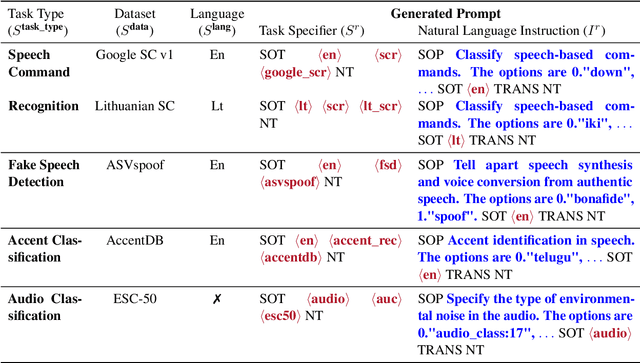

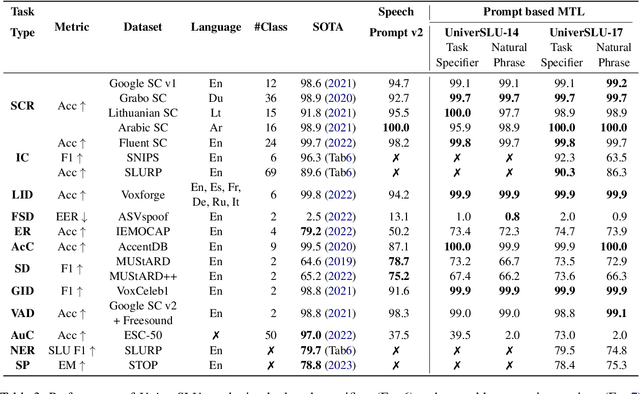
Abstract:Recent studies have demonstrated promising outcomes by employing large language models with multi-tasking capabilities. They utilize prompts to guide the model's behavior and surpass performance of task-specific models. Motivated by this, we ask: can we build a single model that jointly perform various spoken language understanding (SLU) tasks? To address this, we utilize pre-trained automatic speech recognition (ASR) models and employ various task and dataset specifiers as discrete prompts. We demonstrate efficacy of our single multi-task learning (MTL) model "UniverSLU" for 12 different speech classification and sequence generation tasks across 17 datasets and 9 languages. Results show that UniverSLU achieves competitive performance and even surpasses task-specific models. We also conduct preliminary investigations into enabling human-interpretable natural phrases instead of task specifiers as discrete prompts and test the model's generalization capabilities to new paraphrases.
Decoder-only Architecture for Speech Recognition with CTC Prompts and Text Data Augmentation
Sep 16, 2023Abstract:Collecting audio-text pairs is expensive; however, it is much easier to access text-only data. Unless using shallow fusion, end-to-end automatic speech recognition (ASR) models require architecture modifications or additional training schemes to use text-only data. Inspired by recent advances in decoder-only language models (LMs), such as GPT-3 and PaLM adopted for speech-processing tasks, we propose using a decoder-only architecture for ASR with simple text augmentation. To provide audio information, encoder features compressed by CTC prediction are used as prompts for the decoder, which can be regarded as refining CTC prediction using the decoder-only model. Because the decoder architecture is the same as an autoregressive LM, it is simple to enhance the model by leveraging external text data with LM training. An experimental comparison using LibriSpeech and Switchboard shows that our proposed models with text augmentation training reduced word error rates from ordinary CTC by 0.3% and 1.4% on LibriSpeech test-clean and testother set, respectively, and 2.9% and 5.0% on Switchboard and CallHome. The proposed model had advantage on computational efficiency compared with conventional encoder-decoder ASR models with a similar parameter setup, and outperformed them on the LibriSpeech 100h and Switchboard training scenarios.
Integration of Frame- and Label-synchronous Beam Search for Streaming Encoder-decoder Speech Recognition
Jul 24, 2023Abstract:Although frame-based models, such as CTC and transducers, have an affinity for streaming automatic speech recognition, their decoding uses no future knowledge, which could lead to incorrect pruning. Conversely, label-based attention encoder-decoder mitigates this issue using soft attention to the input, while it tends to overestimate labels biased towards its training domain, unlike CTC. We exploit these complementary attributes and propose to integrate the frame- and label-synchronous (F-/L-Sync) decoding alternately performed within a single beam-search scheme. F-Sync decoding leads the decoding for block-wise processing, while L-Sync decoding provides the prioritized hypotheses using look-ahead future frames within a block. We maintain the hypotheses from both decoding methods to perform effective pruning. Experiments demonstrate that the proposed search algorithm achieves lower error rates compared to the other search methods, while being robust against out-of-domain situations.
Integrating Pretrained ASR and LM to Perform Sequence Generation for Spoken Language Understanding
Jul 20, 2023Abstract:There has been an increased interest in the integration of pretrained speech recognition (ASR) and language models (LM) into the SLU framework. However, prior methods often struggle with a vocabulary mismatch between pretrained models, and LM cannot be directly utilized as they diverge from its NLU formulation. In this study, we propose a three-pass end-to-end (E2E) SLU system that effectively integrates ASR and LM subnetworks into the SLU formulation for sequence generation tasks. In the first pass, our architecture predicts ASR transcripts using the ASR subnetwork. This is followed by the LM subnetwork, which makes an initial SLU prediction. Finally, in the third pass, the deliberation subnetwork conditions on representations from the ASR and LM subnetworks to make the final prediction. Our proposed three-pass SLU system shows improved performance over cascaded and E2E SLU models on two benchmark SLU datasets, SLURP and SLUE, especially on acoustically challenging utterances.
 Add to Chrome
Add to Chrome Add to Firefox
Add to Firefox Add to Edge
Add to Edge